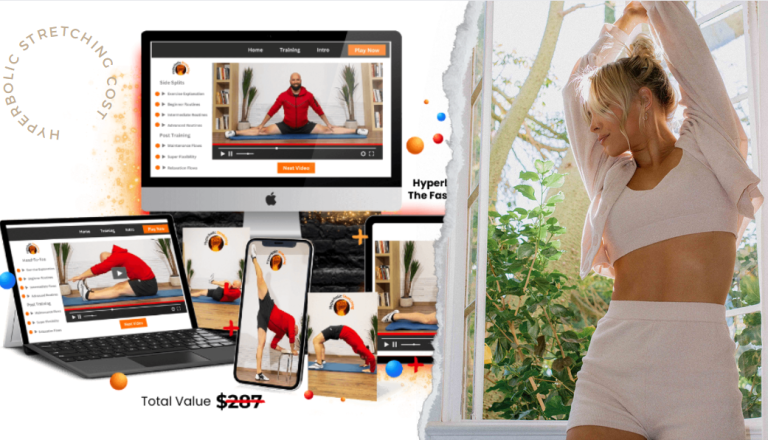
How Does Hyperbolic Stretching Work: Unveiling Flexibility Secrets

Hyperbolic stretching aims to rapidly improve flexibility through a specific set of exercises that push the body beyond its usual range of motion. This technique focuses on overcoming the natural reflex that prevents muscles from stretching beyond a point, known as the myotatic reflex.
Individuals engaging in hyperbolic stretching can achieve greater flexibility by systematically training the body to tolerate and eventually ignore this reflex. Unlike traditional stretching, which may prioritize gradual lengthening of the muscles, hyperbolic stretching targets the nervous system and the muscle reflexes for a more immediate increase in range of motion.
The hyperbolic stretching program typically involves a series of stretches that can be completed in a short daily routine, making it accessible to individuals regardless of their busy schedules. As it is primarily available online, the program is suitable for anyone to follow at home.
While it is often promoted with the promise of achieving impressive results, such as a complete split in a relatively short period, it is important to approach such claims cautiously. The scientific backing regarding the efficacy of hyperbolic stretching varies, and the results can depend on a person’s unique body and consistent practice.
Key Takeaways
- Hyperbolic stretching aims to quickly increase flexibility by targeting the body’s myotatic reflex.
- The routine is short and designed for easy incorporation into daily schedules.
- Its effectiveness can vary, highlighting the need for personal consistency and claim caution.
Understanding Hyperbolic Stretching
In exploring hyperbolic stretching, we uncover a scientific approach designed to enhance flexibility and muscle function using specialized stretch routines.
Origins and Developer
Alex Larsson, a stretching and flexibility expert, popularized the concept of hyperbolic stretching. Larsson’s work has codified ancient stretching methods into a modern, structured program, identifying stretching as an essential component of physical fitness.
Mechanics of the Program
Hyperbolic stretching is a 30-day digital program that utilizes a specific set of dynamic, static, active, and ballistic stretches. This 4-week program is methodically crafted to improve flexibility through well-designed stretches gradually.
Types of Stretching Involved
At the core of the program are various types of stretches:
- Dynamic stretches: Recommended at the beginning of the routine for warming up muscles.
- PNF stretching involves a stretch-and-contract approach and is ideal for improving muscle elasticity.
- Static stretches: Essential for cooling down and increasing muscle relaxation post-exercise.
- Active stretches: Help to stabilize and strengthen muscles in their extended state.
- Ballistic stretching: Used carefully to push muscles slightly beyond their range.
Our method of hyperbolic stretching is an online platform, making it accessible for those looking to enhance their flexibility and muscle strength through a consistent stretching regimen.
How Hyperbolic Stretching Works

Hyperbolic stretching is designed to increase flexibility and range of motion through specific exercises. This routine, often consisting of an 8-minute stretching sequence, leverages natural body reflexes to push beyond the typical flexibility limits.
Improving Flexibility and Range of Motion
Our muscles have a natural protective reflex that prevents overstretching, known as the myotatic reflex. Hyperbolic stretching works by gradually decreasing the sensitivity of this reflex, which allows us to achieve more excellent movement range. Improving flexibility, particularly in the lower body, involves exercises that target the pelvic floor muscles and can lead to enhanced athleticism and reduced risk of injury.
Hyperbolic Stretching Routine
A typical hyperbolic stretching routine is concise, usually completed in around 8 minutes, and designed for daily practice. The routine includes progressive stretching exercises that aim to improve flexibility quickly. For those looking into increasing flexibility, specific hyperbolic stretching exercises guide the body through advanced poses that may initially seem challenging.
Results and Expectations
When undergoing hyperbolic stretching, results can vary depending on the individual’s commitment to the routine and their initial level of flexibility. Some may see results in as little as four weeks, while others might take longer. The overall time spent stretching is minimal compared to traditional methods, with the expectation that consistent practice will yield significant increases in range of motion and flexibility within a month.
Related Posts:
- Is Hyperbolic Stretching Routine Free? Everything You Need to Know!
- What is Hyperbolic Stretching for Beginners
Program Details and Accessibility
Hyperbolic stretching is touted for its structured approach to flexibility and strength training. Our focus on clear, organized content ensures the program caters to users seeking tangible benefits from their stretching routines.
Program Structure and Content
The core of hyperbolic stretching is a 4-week program that methodically advances through a series of stretching routines. Users are introduced to exercise videos that target flexibility and muscle strength each week. We pride ourselves on providing a comprehensive guide that gradually builds user competence and confidence in completing these exercises.
- Week 1: Foundation of flexibility and basic stretches
- Week 2: Advanced stretches and muscle strengthening
- Week 3: Techniques to Enhance Muscle Elasticity
- Week 4: Mastery of entire routine for optimal flexibility
Guarantees and Support
To ensure customer satisfaction, we offer a 60-day money-back guarantee. If users are not satisfied with their progress, they have the liberty to request a refund. Support is readily available, offering personalized assistance to users as an integral part of their journey with our program.
- Customer Assurance: Clear instructions for refund requests
- Support Mechanism: Access to customer service for help
Availability and Updates
Our program is readily available for purchase online, providing lifetime access to the content. We stay ahead by updating our exercise videos and instructional material regularly, ensuring our methods remain in line with the latest in stretching and flexibility practices.
- Immediate Access: Online purchase with instant program availability
- Long-Term Value: Free updates included with lifetime access
Scientific Backing and Efficacy
As we explore the concept of hyperbolic stretching, it’s crucial to examine the scientific evidence supporting its effectiveness compared to traditional forms of stretching.
Research on Stretching
In our analysis of hyperbolic stretching, we’ve noticed that it diverges from conventional static stretching routines. While traditional static stretches are widely recognized and implemented in fitness regimes, hyperbolic stretching aims to enhance flexibility and muscular strength in a shorter timeframe.
Several studies have validated the benefits of regular static stretching for increasing flexibility and aiding in muscle recovery. Conventional static stretching, often an integral part of warm-down routines, has improved joint range of motion and decreased stiffness. However, the claims of hyperbolic stretching go beyond what is achieved through conventional means.
To illustrate, a particular study, Current Concepts in Muscle Stretching for Exercise and Rehabilitation, provides insights into how dynamic stretching might influence muscle performance differently than static stretching. While this study doesn’t specifically deal with the term ‘hyperbolic stretching,’ it elucidates the broader context in which stretching techniques are assessed for their impact on muscle function.
In our ongoing investigation, we emphasize the need for peer-reviewed research that scrutinizes hyperbolic stretching directly. As of our knowledge cutoff, detailed scientific scrutiny of hyperbolic stretching is less extensive than more traditional methods. Therefore, we remain vigilant for emerging studies that could affirm the program’s efficacy with empirical evidence.
Frequently Asked Questions
In our exploration of hyperbolic stretching, we’ll address some common inquiries about how it works and what sets it apart from other stretching techniques.
What are the core principles behind hyperbolic stretching?
Hyperbolic stretching improves flexibility and strength by stretching the muscles beyond their usual range of motion. The technique promises increased flexibility and muscle strength by leveraging the body’s natural stretch reflex and improving neural adaptation.
Can hyperbolic stretching effectively aid in weight loss?
While hyperbolic stretching predominantly targets flexibility and muscle strength, it is not specifically designed for weight loss. Any weight loss would be a secondary effect due to increased muscle engagement and improved exercise performance.
How is hyperbolic stretching adapted for seniors?
Seniors can benefit from hyperbolic stretching as it can be adapted to suit lower fitness levels and accommodate a range of flexibility issues that may come with age. The exercises can help improve balance, reduce stiffness, and increase range of motion.
What differentiates hyperbolic from proprioceptive neuromuscular facilitation (PNF) stretching?
Hyperbolic stretching primarily concerns pushing the muscles to elongate further than usual. In contrast, PNF stretching involves stretching and contracting the target muscle group to enhance flexibility through a neuromuscular response.
How long does it usually take to see results from a consistent stretching routine?
Results can vary depending on the individual, but generally, consistent stretching can yield noticeable improvements in flexibility within as little as four weeks, as suggested by some hyperbolic stretching programs.
What are some credible critiques of the hyperbolic stretching program?
Some critiques of hyperbolic stretching indicate that results may not be as rapid or extensive for everyone, and the program’s claims may not have robust scientific backing. These critiques emphasize the necessity for research and individual assessment before participating in such programs.



